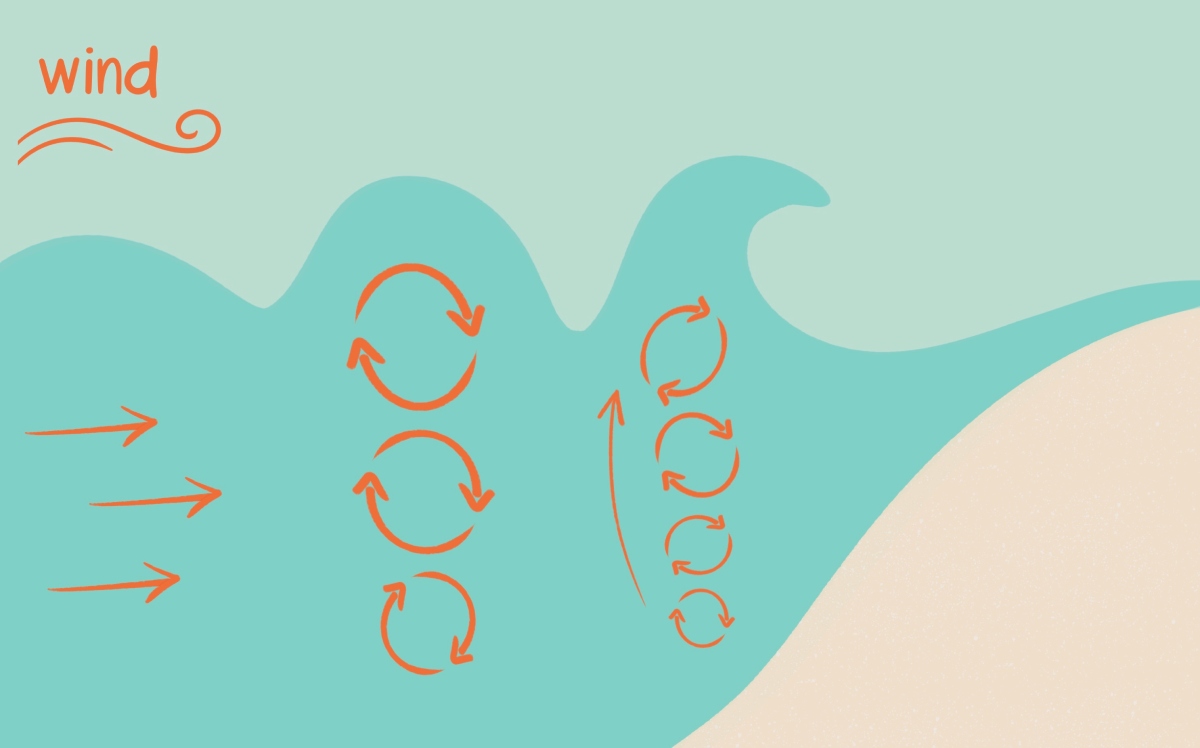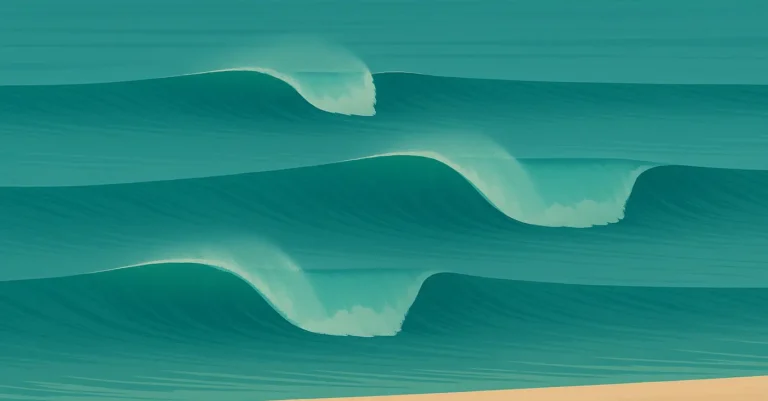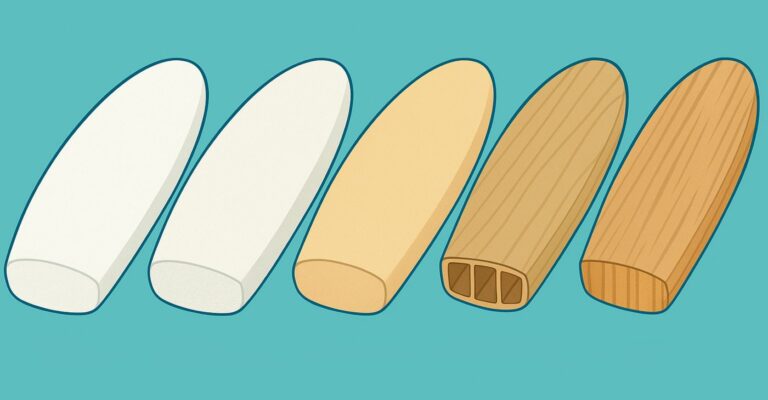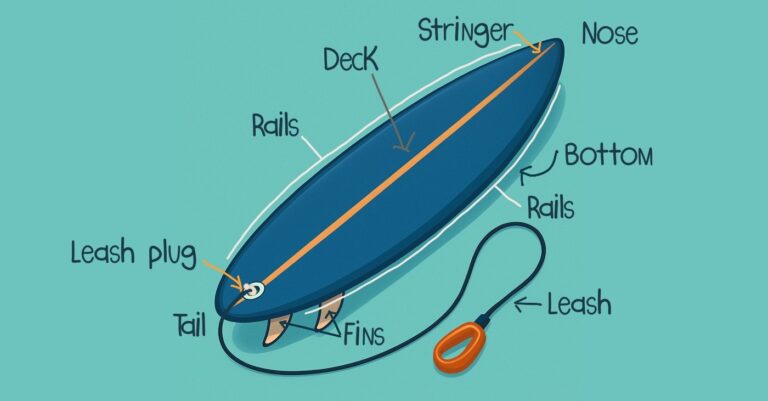Glassy or big waves, the sea has fascinated people for centuries. But how are these impressive masses of water created in the sea? In this article, we explore the influences behind wave formation and reveal how wind, water and underwater landscapes interact to create the perfect waves for surfers. From the depths of the ocean to the coasts. With this article, you’ll be well-informed about how the waves you surf are created. Or you’ll know in case anyone asks you: How do waves actually occur?
The wind in wave formation
Waves are mainly caused by the effect of wind on the surface of the water. This in turn can be the case with pressure differences and air turbulence, among other things. In both cases, the energy of the wind is transferred to the water, causing water particles to begin to oscillate in circular paths. This movement not only causes waves on the surface, but also affects the water at depth. The process of wave formation depends on the wind speed, the wind duration and the water surface over which the wind passes. The stronger and longer the wind blows on a large water surface, the bigger and cleaner the waves will be – ideal conditions for surfing.

From the following table (Beaufort-Scale) you can see at which wind force you can expect which wave size (meters). As the unit of wind speed depends on your own preference as well as on the unit of your country, it is given in various units: Meters per second (m/s) kilometers per hour (km/h), miles per hour (mph) and knots (kts).
Description of the state of the open sea by wind force
The following table describes visual reference points for the various wind forces on the high seas. This will give you a better idea of what the sea looks like at the corresponding wind forces.
| wind force (Bft) | description of the wind force | visual clues in the open sea |
|---|---|---|
| 0 | calm | mirror-smooth sea |
| 1 | light air | slight ripple waves |
| 2 | light breeze | small, short waves |
| 3 | gentle breeze | small and short waves, foaming begins |
| 4 | moderate breeze | small, lengthening waves with fairly regular foam heads |
| 5 | fresh wind | moderate waves in longer form with strongly pronounced foam heads formation of spray possible |
| 6 | strong wind | large waves with breaking heads and white foam patches everywhere |
| 7 | stiff wind | white foam, caused by breaking wave heads, is blown in the direction of the wind (foam streaks) |
| 8 | stormy wind | high wave crests, foam streaks everywhere |
| 9 | storm | high waves with blown spray, breakers begin to form |
| 10 | severe storm | very high waves (heavy breakers) appear, visibility is restricted |
| 11 | violent storm | Water is blown away horizontally, severe reduction in visibility in raging seas |
| 12 | hurricane | sea completely white, the air is full of foam and spray, no more visibility |
Topographical and geological influences on wave formation
The nature of the seabed and the coastline play a decisive role in the shaping of waves. Shallow bottoms or sudden changes in depth (e.g. sandbanks and reefs) can cause waves to break. Probably the best-known example of waves with a unique geological influence is in Nazaré. The small fishing village in Portugal is world-famous for its unique waves. A canyon located under the water guides the waves onto a continental plate. The plate acts as a kind of ramp and creates the highest waves in the world. The canyon is around 2.4 miles deep and 143 miles long, and becomes narrower and narrower the closer it gets to the shore: the power of the wave gradually compresses until it finally breaks near the coast. A water channel on the shore pushes additional water towards the canyon, providing more water to build up the gigantic wave.
As a rule of thumb: the more abruptly the depth of the water level is reduced, the steeper and more violently the waves break (e.g. on reefs). In contrast to less sudden changes in water depth due to shallow sandbanks, the more gently the wave breaks.
Further fascinating wave phenomena
- Giant waves: These are extremely large waves that can occur suddenly and unexpectedly in the middle of the sea. They are notorious for their size and power and pose a serious threat to ships and offshore structures (buildings on the open sea). Giant waves (also known as monster waves or freak waves) are caused by the overlapping of several wave systems, whereby their energies add up and form exceptionally high wave crests. The logbook of the MS Bremen, led by the experienced captain Heinz Aye, describes a 114-feet-high monster wave that crashed onto the steel hull of the cruise ship and almost sank it in the Antarctic Ocean.
- Tsunamis: Unlike normal waves, tsunamis are not caused by wind, but by undersea earthquakes, volcanic eruptions, or volcanic eruptions. Tsunamis (Japanese for “big waves in the harbor”) have an enormously higher energy and destructive potential compared to ocean waves, which are caused by the effect of wind. This is because the huge wave masses spread out in a ring shape at high speed over long distances, leaving catastrophic damage in their wake. One example is the tsunami caused by an undersea earthquake in the Indian Ocean in 2004, which claimed over 400,000 lives.
- Landslide waves: Landslide waves occur when large amounts of soil or rock fall into the water, for example on steep coasts or in reservoirs. The sudden submersion of these masses displaces the water and creates large waves that can spread rapidly and cause considerable destruction. Iceberg waves: In regions where large masses of ice calve into oceans or lakes, the collapsing icebergs can generate large waves. These waves can be observed particularly in the Arctic and Antarctic, but also in Patagonia, where the melting of glaciers is increasingly leading to such phenomena.
- Iceberg waves: In regions where large masses of ice calve into oceans or lakes, the collapsing icebergs can create large waves. These waves can be observed particularly in the Arctic and Antarctic, but also in Patagonia, where the melting of glaciers is increasingly leading to such phenomena.
- Meteorite waves: Rare, but with devastating potential, are waves caused by the impact of a meteorite in the ocean. The energy of the impact creates a massive displacement of the water, resulting in extremely high waves that spread radially from the impact site. Meteorite waves propagate in a ring shape, like the waves of tsunamis. The height of the wave depends on the size and speed of the meteorite.
The influence of the tides on the waves
Gravity and tides
Tidal cycles
The tidal cycles are subject to both daily and monthly fluctuations. On a daily basis, most coastal regions experience high and low tides twice a day. These cycles are particularly pronounced at new moon and full moon, known as spring tides, when the sun, moon and earth are in alignment. The combined gravitational pull and centrifugal force of the sun and moon results in higher and lower tides. If you would like to learn more about the tides, you can watch this video on how tides are formed.
Effects on waves
Waves for surfing – what does it depend on?
Shred heads, chargers, and surf enthusiasts prefer clean, smooth, and powerful waves. The less choppy and more powerful they are, the easier it is to perform turns, aerials, and other maneuvers. For powerful waves, it is necessary that they form far out in the ocean, with long-lasting, widespread wind. This creates ground swells, which form over a longer period of time and are more orderly. These waves have more power and break in a more orderly fashion. You can recognize ground swells when reading the surf forecast from a wave period of approximately 15 seconds.
Depending on the surf spot, it also depends on the water level; many surf spots only work, or work particularly well, at certain tides due to their geological location or their subsoil. If you want to find out at what time a particular surf sport works best, it is best to talk to the locals or watch the waves at different tides to get the best wave conditions.
Tip: If the waves in the lineup are too big for you, the following quote may help you to stay mentally calm and focused and master the challenge.
“Waves are not measured in feet and inches; they're measured in increments of fear”
Buzzy Trent
When Does a Wave Stop Growing?
A wave stops growing when it breaks. This is due to the underlying structure, when the wave encounters rising ground and piles up. Waves break at the critical water depth at which the wave loses stability. This depth is approximately 1.3 times the height of the wave. However, wind can also influence the breaking of a wave. When the wind is onshore, it pushes the waves down and they break earlier. In contrast, when the wind is offshore, it stabilizes the wave and allows it to grow even larger before it breaks. Here, the wave becomes steeper and steeper, and the point at which the wave breaks is also called critical steepness. At this point, the wave can no longer maintain its steep shape and breaks.



